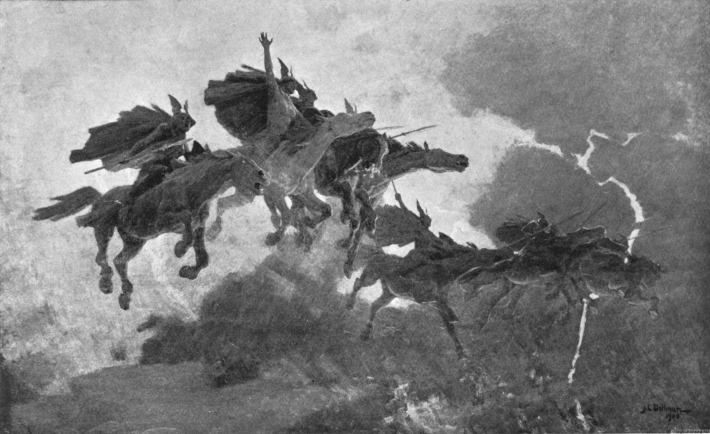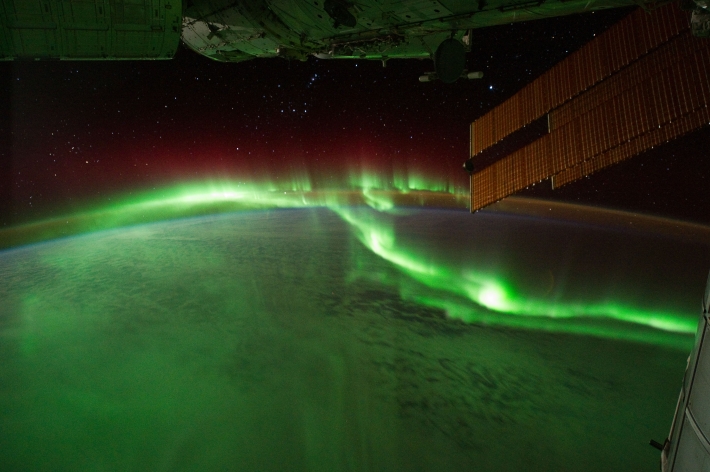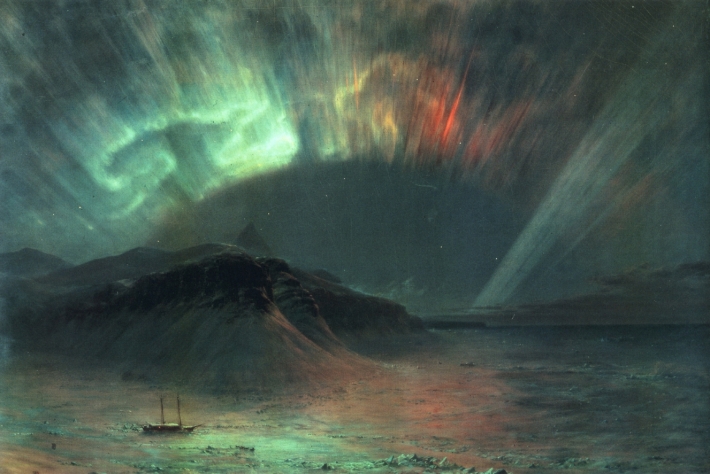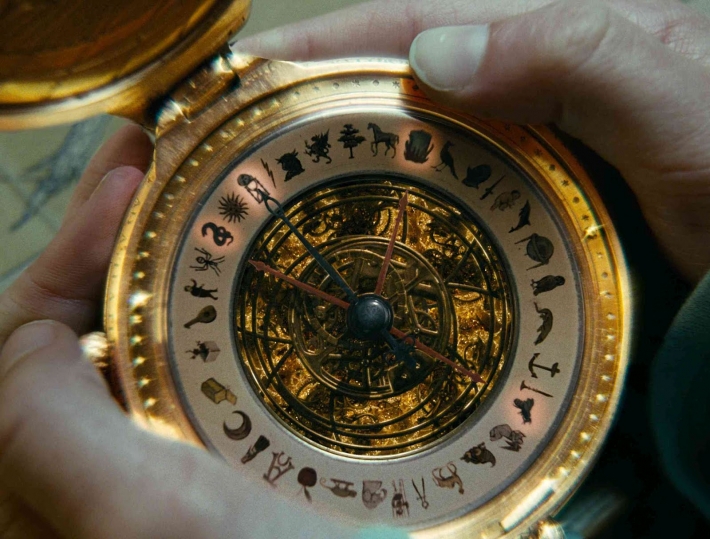The aurora has long been a source of myth and legend, a mysterious light show in the heavens. There are still aspects behind this phenomenon that are a mystery and its infrequent appearances and its beauty still enchant and excite those lucky enough to see it. Trips are planned specially to view the aurora borealis, or the Northern lights and tracking magnetic activity to discover the best times to see it is a career for some and a hobby for many.
We are currently in the middle of a peak time to see the aurora. The prevalence of the aurora in our skies is largely dependent on magnetic solar activity. Large magnetic storms occur most frequently during the peak of the sun's eleven year cycle, and for three years following that peak. Last year (2013) was the peak, and so sighting the aurora will be more likely until about 2016. If you're keeping an eye out for the beautiful lights in the sky, the best time for viewing is around 11.30pm, magnetic midnight, according to the Finnish Meteorological Institute. However, it is likely that you might see some activity any time between 9pm and 5am, as the lights are more visible at night. A clear sky with no clouds also gives the best chance of a sighting. The best times for year for spotting the aurora are at the beginning of Spring and the beginning of Autumn. It is not impossible to see the aurora in places close to the equator, but the likelihood of it being visible increases the closer you are to the poles. In the most northernmost area of Lapland, the aurora borealis is an almost constant phenomenon and appears roughly every three nights out of four.
It's unsurprising then that most of the myths about the aurora arise from cultures far North in the Northern hemisphere, or very far South in the Southern hemisphere.
The Finnish name for aurora is revontulet, which translates as 'fox fires', deriving from Finnish folklore that tells of fire foxes in Lapland that gives off sparks from their tails as the sweep across rock faces and snow in the mountains. In Greenland, the aurora is purportedly the souls of dead children competing on their way to the Otherworld. The Old Norse word for the aurora borealis is norðrljós, "northern lights". There are many wonderful myths supposedly believed by the Vikings as an explanation for the aurora borealis, from the belief that it was the Norse God Ullr putting on a show of lights to the suggestion that it was the Bifröst Bridge, which dead Vikings crossed on their way to Valhalla. Bulfinch's Mythology, written in 1855, claims that Norse mythology spoke of the aurora being Valkyries riding through the night sky.

'Ride of the Valkyries'.
Credit: John Charles Dollman
The Valkyrior are warlike virgins, mounted upon horses and armed with helmets and spears. /.../ When they ride forth on their errand, their armour sheds a strange flickering light, which flashes up over the northern skies, making what Men call the "aurora borealis", or "Northern Lights".
-- Thomas Bulfinch, 'Bulfinch's Mythology' (1855)
However, texts from the era rarely mention the Northern lights. It's possible that they're weren't sighted frequently, but an absence in literature doesn't necessarily mean they weren't observed and discussed.
In the Southern hemisphere, the aurora australis has been commonly associated with fire in the legends of the Aboriginal Australians. The phenomena is apparently the result of bush fires in the spirit world, or are the result of ghostly spirits lighting fires.
Explanations for the Northern lights have often involved deities or otherworldly spirits, apparently producing visible evidence for their existence. Though the myths seem fanciful, it seems they were not wrong in assuming that the lights were caused by forces external to Planet Earth. The aurora is in fact a product of solar activity exerting an influence on the Earth's atmosphere. The surface of the sun is an extremely toasty two million degrees, with radiation emitted constantly from its outer layer, known as the corona. Clouds of hot gas are ejected by the outer layer, in what is known as a Coronal Mass Ejection (CME). It takes about 2 to 3 days for the gas cloud, or solar wind, to reach Earth, where it collides with the Earth's thermosphere. The solar wind consists of ions, charged particles, which are trapped by the Earth's magnetic field. Many particles travel towards the poles, where they are accelerated towards Earth. While they are in the Earth's upper atmosphere, the ions in the solar wind collide with oxygen and nitrogen atoms in the atmosphere. This releases energy as photons, packets of coloured light that produce the aurora.

The aurora as seen from the International Space Station.
Credit: NASA
The oxygen and nitrogen atoms give off different coloured light as they gain and lose electrons in the course of the collisions. Their electrons gain energy, rising them into an excited state, by the collision with the solar wind. This excitation energy is subsequently lost as the electrons return to ground state, and emitted in the form of a photon. The energy difference between the excited state and ground state of the electron determines what frequency of light is emitted. Light emissions from oxygen atoms are either green or orange-red, depending on how much energy they have absorbed. Nitrogen atoms emit blue light is the atom is regaining an electron lost during the collisions, red if it is returning to ground state from an excited state.
So the colours produced during as aurora are determined by the elements involved. At high altitude, red oxygen emissions are most prevalent, followed by green oxygen emissions and nitrogen blue/red emissions. Green is the most common of all auroras. Pink is next common, caused by a mixture of light green and red emissions. This is followed by pure red, yellow (caused by a mixture of red and green) and lastly, blue.
Metaphorically speaking, the aurora is a sign of the Sun God's wrath, as he/she showers Earth with radiation from solar fires.
Before the eighteenth century, the cause of the aurora was a a mystery to those writing about it, prompting some strange and beautiful myths. However, the discovery of the electromagnetic activity behind the aurora did not dampen its popularity as a source of poetic inspiration. In fact, for the romantic poets, this explanation of the aurora fitted the metaphor of electricity representing a power to animate the mind, and prompt bursts of creative energy.
Coleridge's ballad 'The Rime of the Ancient Mariner' appears to allude to the aurora australis during a storm at night.
The upper air burst into life! / And a hundred fire-flags sheen, / To and fro, they were hurried about! / And to and fro, and in and out, / The wan stars danced between.
-- Coleridge, 'Rime of the Ancient Mariner', ll. 313-317
This celebratory light show occurs just before the dead crew are reanimated and resume their positions manning the ship. The military symbolism of 'fire-flags' and the stars prompted into creative activity dancing suggests that the electricity of the aurora has the power to galvanise and prompt a reawakening of the mind and creative activity. It is a natural source of power that could be confused with magic.

Aurora Borealis.
Credit: Frederic Edwin Church
Also from 'Lyrical Ballads', William Wordsworth's 'The Complaint of a Forsaken Indian Woman' depicts the aurora borealis through a vision experienced by an abandoned Indian woman.
In sleep I heard the northern gleams / The stars, they were among my dreams / In rustling conflict through the skies / I heard, I saw the flashes drive / And yet they are upon my eyes / And yet I am alive / Before I see another day / Oh let my body die away!
-- Wordsworth, 'The Complaint of a Forsaken Indian Woman, ll. 3-10.
Though primarily regarded as a visual phenomenon, Wordsworth introduces the aurora by describing the sound it produces, 'rustling conflict'. It seems to be describing the possible sounds of the charged particles colliding with atoms in the upper atmosphere.
It is generally believed, in some countries where the aurora is prevalent, that the aurora generates a crackling or rustling sound. The Lapps compare this to the cracks made by the joints of reindeer when they walk. Though accounts are variable, a recent study seems to confirm that the aurora is in fact accompanied by sound. They suggest that clapping noises can be heard about 70m (230 feet) off the ground during aurora activity. Similar geomagnetic activity has been seen to produce similar sounds, but it is not yet proven that these claps are directly related to the aurora borealis.
Philip Pullman's 'His Dark Materials' trilogy of books features the aurora borealis, creating further mythology for this phenomenon. Whereas Coleridge likens the aurora to a collection of flags, Pullman describes
'streams and veils of light [hanging] like curtains'
-- Pullman, 'Northern Lights', p 15.
This foreshadows Lord Asriel's presentation of a photograph that shows a city in the sky, visible within the Northern Lights. Here the aurora is a veil concealing a window to another world. In this case, the other world visible in the treated photograph is Cittàgazze, a city in a parallel universe.
It wasn't long before she found herself entering the same kind of trance as when she consulted the alethiometer. Perhaps, she thought calmly, whatever moves the altheiometer's needle is making the aurora glow too. It might even be Dust itself. She thought that without noticing that she'd thought it, and she soon forgot it, and only remembered it much later.
And as she gazed, the image of a city seemed to form itself behind the veils and streams of translucent colour: towers and domes, honey-coloured temples and colonnades, broad boulevards and sunlit parkland. Looking at it gave her a sense of vertigo, as if she were looking not up but down, and across a gulf so wide that nothing could ever pass over it. It was a whole universe away.
-- Pullman, 'Northern Lights', p 111-112
As Lyra surmises, Dust must be the factor influencing the Northern Lights, her alethiometer, among other seemingly magical occurrences in her world. Dust is a fictional elementary particle that is of great importance in the trilogy. It is invisible to the human eye and is only visible with the use of special instruments, though it becomes more visible in the light of the aurora borealis. This invisible force has a huge effect on the world and the people who inhabit it. In this respect, it could be likened to electromagnetic activity, which has silent and invisible effects on the human body, as I mentioned in a recent article about ghosts.

Lyra's Alethiometer in 'The Golden Compass'.
Credit: New Line Cinema
Pullman's explanation of the aurora's ability to act as a window to another world sounds more like science fiction than complete fantasy, as he suggests the charged particles make the layers between universes thinner. He explains that millions of other universes exist, unaware of each other. Serafina Pekkala's demon explains to Fader Coram why a city is visible in the Northern Lights.
"There," he said, "I have just brushed ten million other worlds, and they knew nothing of it. We are as close as a heartbeat, but we can never touch or see or hear these other worlds except in the Northern Lights."
“And why there?” said Farder Coram.
"Because the charged particles in the Aurora have the property of making the matter of this world thin, so that we can see through it for a brief time. Witches have always know this, but we seldom speak of it."
-- Pullman, 'Northern Lights', p 114
Pullman's fantasy of the aurora as a gateway to other universes doesn't claim to explain the origins of the phenomenon, nor explain how they work. He makes use of current scientific understanding of how the aurora works and extrapolates this to propose they are a sign of greater forces at work in the universe, of multiple universes beyond our sight.
As opposed to stifling the imagination and poetic inspiration to be found in these beautiful phenomena, discovering the science behind how they work has prompted new fantasies about what they represent and how microscopic processes can have an effect that appears to be the product of fantasy.
References & Further Reading
- Bulfinch, 'Bulfinch's Mythology' (1855).
- Coleridge and Wordsworth, 'Lyrical Ballads, with a Few Other Poems' (1798).
- Pullman, 'Northern Lights', Scholastic UK (1995).
- 'The Golden Compass', New Line Cinema (2007).
- Cooper, 'A Dissertation Upon Northern Lights', Modern Language Notes 21.2 (1906): 44-46.
- Hall, 'Wordsworth And Emerson: Aurora Borealis And The Question Of Influence', Romanticism And Victorianism On The Net (2008).
- Jutström,"Northern Lights: Beliefs in Ancient Times", Norrsken History Website (2011).
- The Viking Answer Lady, 'The Aurora Borealis And The Vikings'.
Listing image: Rocklou / DeviantArt
